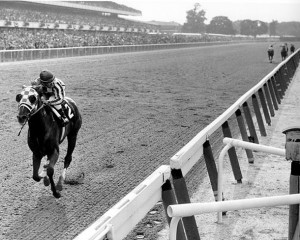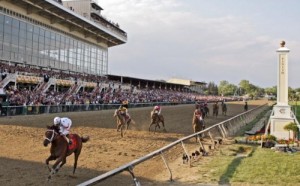Posted on
May 05, 2011 by
Dean Hybl

Secretariat dominated thoroughbred racing in 1973 and was named as the 35th greatest athlete of the 20th Century.
There was a time when the most important sporting event on the first weekend of May wasn’t the NBA or NHL Playoffs, but rather a two minute race between the fastest three-year-olds on four legs. While still an exciting event for those lucky enough to make it to Churchill Downs, the Kentucky Derby and thoroughbred racing in general isn’t quite the national obsession that it once was.
However, the history of this regal sport is laced with many great champions, some of whom captured the spirit and hearts of the American public.
While greatness for a thoroughbred is often identified with winning the famed Triple Crown (Kentucky Derby, Preakness Stakes and Belmont Stakes), only some of the best known horses actually claimed that distinguished honor.
Chances are you have never heard of the first Triple Crown winner, Sir Barton, in 1919, but may have heard about the legendary Man O’War, who many consider the greatest horse of all-time with victories in 20 of his 21 races. However, Man O’War did not follow Sir Barton as a Triple Crown winner during his three-year old year of 1920 as his owner held him out of the Kentucky Derby. Read the rest of this entry →
Tags: Horse RacingKentucky DerbyMan O' WarSecretariatsmarty jones
Category
Great Moments, Horse Racing, Sports History
Posted on
February 22, 2011 by
Rod Crowley
 The Grade One Preakness Stakes is known also as the “The Run for the Black Eyed Susans” due to the blanket of the Maryland State flower being traditionally draped over the winner’s neck at the end of the race.
The Grade One Preakness Stakes is known also as the “The Run for the Black Eyed Susans” due to the blanket of the Maryland State flower being traditionally draped over the winner’s neck at the end of the race.
The race is run annually over 9½ furlongs on a dirt track at the world famous Pimlico Racecourse in Baltimore, Maryland and is recognized as the second leg of the highly coveted American Triple Crown, which comprises of the Kentucky Derby (first leg) and Belmont Stakes (third leg). The attendances at the race are the second highest in the sport, with only the Kentucky Derby at Churchill Downs attracting more spectators, in 2010, 95,760 people attended but that was down from over 121,000 in 2007 following the banning of fans being able to bring their own beer. The race is open to colts and fillies, with the ‘boys’ having to carry 126lb and the girls 5lbs less.
The history of the race dates back to 1873 (2 years before the Kentucky Derby) when Pimlico introduced a new quality Stakes race for three year olds. It was called Preakness in honour of a colt of the same name, who was the winner of the feature race on the day that Pimlico first opened in 1870. The first ever race was won by My Sheba who won by 10 lengths in fantastic style which remained the most emphatic victory in the race until 2004 when Smarty Jones, who had won the Kentucky Derby two weeks previously, came home by 11 lengths. Smarty Jones was then aimed at the Belmont Stakes where he became an odds on favorite in the Belmont Stakes betting to win the race and thus the coveted Triple Crown, which had not been won since Affirmed achieved the feat in 1977. In heart breaking fashion however this hugely popular colt, whose presence at Belmont Park had attracted it’s biggest ever crowd, was to be denied in the ‘Belmont’ by the late run of 36/1 outsider Birdstone. Read the rest of this entry →
Tags: belmont stakeshistorypimlicopreakness stakessmarty jones
Category
Horse Racing





